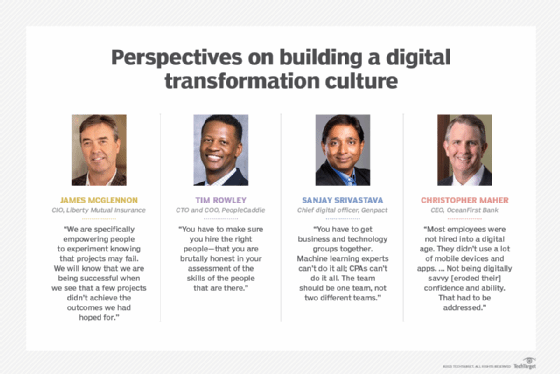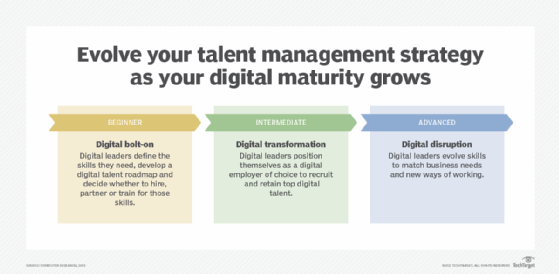
sdecoret - stock.adobe.com
The importance of culture in digital transformation
Trying to accomplish digital transformation without the right culture could result in failure to launch. Here are five steps you need to take to get off the ground.
Chris Maher saw the handwriting on the wall. OceanFirst Bank had been relying on numerous neighborhood branches to meet its customers' needs. But when those customers began to clamor for digital services, Maher, the CEO of OceanFirst, realized there could be but one response: digital transformation. The work began with a top-to-bottom assessment of the New Jersey-based regional bank's capabilities and how they stacked up against a digital future.
"We benchmarked ourselves against other banks and companies in other industries. The majority of our gaps were not technical, but cultural and behavioral," Maher said.
Maher is hardly alone. "The people are more important than the technology," said Tim Rowley, erstwhile leader of digital transformation at Bank of America and now CTO and COO at PeopleCaddie, an employment site that calls itself "a talent cloud for the highly skilled gig economy."
Despite its undeniable importance, organizational culture is sometimes overlooked. In a survey of IT leaders involved in digital transformation conducted by Forrester Research, company culture did not stand out as a top challenge to executing digital transformation. Security ranked first in that study at 23%, while company culture was tied with four other factors for fourth place at 17%. But neglect of culture could incur serious consequences, according to Alyson Clarke, principal analyst at Forrester.
"If elements of your culture won't work, it will grind your digital transformation to a halt at some stage. No matter how good the technology is, you can't overcome a culture that is not digital and innovative," Clarke said.
Five steps to create a digital transformation culture
Here are the steps you can take to build a digital -- and innovative -- culture.
1. Set the digital transformation vision
Envisioning a business's digital destination is the first step. Organizations reach this starting point in many different ways. Some, like Maher, pick up new signals from customers. Others do not seek out digital transformation but instead have it thrust upon them by external forces, according to Ramnath Chellappa, associate dean at Emory University's Goizueta Business School.
"More often than not, digital transformation is due to an exogenous shock," Chellappa said, pointing to the Y2K crisis and Sarbanes-Oxley requirements as two previous external catalysts that spurred overhauls of business technology. COVID-19 is emerging as a similar catalyst that is causing organizations to rethink business processes, he said.

According to a report by McKinsey & Company, the COVID-19 crisis has accelerated the digitization of customer interactions by three years globally. McKinsey found that companies are leaping ahead by seven years worldwide in developing digitally enhanced products and services.
Once the ultimate goal is fixed, employees must share it. "Start with an inspiring vision. Consistently communicate it to the organization to get everyone to map to their better selves," Rowley said. Only after the vision has been imparted should an organization distill it into a series of achievable milestones, he explained.
2. Make risk-taking acceptable
Although digital startups might eagerly embrace risk as they disrupt industries, for established companies, the risk calculus is more complex for one simple reason: They have much to lose. An erroneous decision or poor execution can throw a company into a fatal tailspin. Nonetheless, higher tolerance of risk is a necessity of going digital. How then to find the right balance?
Shawn Fitzgerald, research director of digital transformation strategies at IDC said the best approach is to set up an innovation center or lab in which disruptive strategies can be tried out. "You don't want to put the business at risk, but within a bounded area, decide you're going to allow some risks," Fitzgerald said.
James McGlennon, CIO at Liberty Mutual Insurance, said a little failure can be a good thing. "We are specifically empowering people to experiment knowing that projects may fail," he said. "We will know that we are being successful when we see that a few projects didn't achieve the outcomes we had hoped for," he added, explaining the key is to look on digital transformation failures as opportunities to learn what to do differently next time.
At OceanFirst, Maher embraced risk incrementally. Needing capital to invest in digital initiatives, he began by cutting back on night branch hours, spending the money saved on digital application development. He followed up with a far bolder move: eliminating 53 branches, slimming the bank down to only 63. "If your customers are going digital, you have to divert some money from brick-and-mortar to digital. That is a high-risk decision." Instead of diminishing customer service, however, Maher said OceanFirst poured the savings into a new customer care center.
OceanFirst Bank invests in digital transformation
- Certified over 500 employees as digital bankers with knowledge of online processes and apps.
- Reduced brick-and-mortar branches from 116 to 63 while investing in digital technology and customer service center.
- Developed employee familiarity with online payment tools such as Venmo.
- Achieved high customer satisfaction: Seventy out of 100 customers would recommend the bank to friends versus banking industry norm of 40 out of 100.
3. Hire and train for digital skills
With goals and strategy in place, it's time for a hard-headed assessment of current employees' skills: Will they be sufficient to take an organization to its digital destination? "You have to make sure you hire the right people -- that you are brutally honest in your assessment of the skills of the people that are there," Rowley said, adding, "The main challenge to organizational transformation is overcoming employee resistance."
Faced with a future that will be very different from the past, many employees have a decision to make: Stick around and learn new skills through internal or online training -- or move on. At OceanFirst, there was a cultural disconnect for some workers that led to an overall workforce reduction. "Most employees were not hired into a digital age. They didn't use a lot of mobile devices and apps. They didn't use mobile payments or remote deposit. Not being digitally savvy [eroded their] confidence and ability. That had to be addressed," Maher explained.
While employees skilled in data science and artificial intelligence should be hired as necessary, workforce transformation goes far beyond hiring a few digital superstars, according to Clarke of Forrester. "If [companies] think they don't have to change their culture, but just bring in a couple of key people, often there is a failure to launch," the analyst said. For the workforce to succeed, agile learning -- the ability to quickly learn new skills for new roles -- enables employees to adapt to the new business mission and methods, according to Clarke.
People skills are essential, Clarke said. The ability to resolve differences constructively with co-workers on nonhierarchical teams will be indispensable in any digital journey. "You need to double down on the soft skills."
OceanFirst emphasizes on-camera video skills for new hires. Because the ability to connect with customers across a videoconference link will be critical to the future, Maher insists that new hires take part in a video interview using HireVue, a video interview platform.
4. Build teams and demonstrate leadership
To carry out digital transformation, organizations must build teams for that purpose, incorporating staff with diverse expertise from across the organization.
"You have to get business and technology groups together. Machine learning experts can't do it all; CPAs can't do it all. The team should be one team, not two different teams," said Sanjay Srivastava, chief digital officer at professional services firm Genpact.
At Bank of America, Rowley built teams in every line of business that included digital champions -- employees with strong digital skills and a commitment to the transformational vision and roadmap. "They were expected to work closely with business leaders as the de facto ambassadors for the digital transformation effort. Our digital transformation team cut across all the lines of business. The champions evangelized."
But teams alone aren't enough. Management behavior also must change, according to Fitzgerald of IDC. "Traditional management structure is top-down. It doesn't work in a digital universe. Its time is past," Fitzgerald said. Clarke of Forrester agreed. "Leading self-directed and autonomous teams requires more coaching and less control. It's more like being a mentor than a manager," the analyst said. According to Emory's Chellappa, leadership is critical in building a culture that is tolerant of risk. Will employees be willing to take risk? Only if they know their leader will support them," he said.
As a CEO, Maher of OceanFirst has taken responsibility to use technology himself, including the bank's Apple Watch app. "Leaders must model behavior. If you want to change culture, it's not something you can delegate to someone else," Maher said.

5. Implement, measure and improve
After a digital transformation project is launched, it is necessary to track not just the accomplishment of specific tasks, but the achievement of outcomes, according to Fitzgerald. Doing so keeps employees focused on the ultimate destination in the transformational journey. In this endeavor, the use of key performance indicators (KPIs) is an indispensable management tool, the analyst said.
IDC research found organizations that are successful with digital transformation rely on KPIs far more than organizations that lag. According to IDC, 49% of digitally successful organizations use KPIs for managing and directing daily or weekly activities, while only 39% of organizations without a transformation strategy do the same.
And when digital transformations succeed, positive signs will appear. For example, successful organizations will find they spend less time in online meetings. According to Fitzgerald, IDC research found that organizations with the most comprehensive enterprise digital transformation strategies spend 29.2% less time in multiple online meetings a day than companies with no digital strategy.
At OceanFirst, customer surveys revealed the encouraging news that the bank's initiative was increasing customer satisfaction, while decreasing customer attrition. On the question of whether customers would recommend the bank to friends, 70% of respondents said yes, compared with an industry baseline of 40%, according to surveys by Net Promoter.
At this stage showing commitment and resolve can keep an organization on track, according to Rowley. "Some organizations start a change effort and after a few months are on to something else. It's important to stick with a program with a top-down commitment so that it's not just flavor-of-the-month."
When an organization measures its digital transformation ROI, the findings may not be favorable. When that happens, an underdeveloped digital culture is often the cause.
"When companies look at what they did wrong, they say they did not address culture early enough because it seemed too hard," Forrester's Clarke said.
Looking for more digital transformation resources?
These articles provide advice on budget planning, business benefits, the field's best books and more.
14 need-to-know tips for digital success
6 tips for digital transformation budget planning






